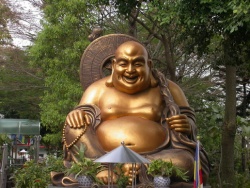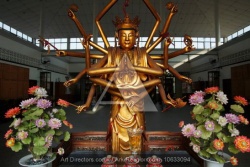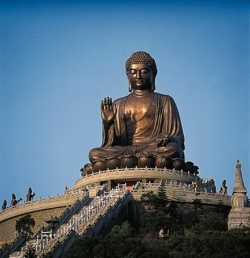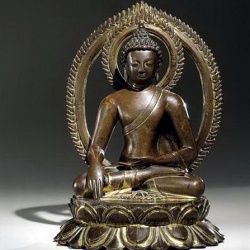Introductory Remark on Pancharaksha Sutra in Mahayana Buddhism by Dr. Shanker Thapa
Pancharakshya is one of the important consecration Sutras that is till in practical use among the Newar Buddhists in Nepal. The belief that multiple benefits can be accrued from using five sutras of Pancharakshya group through recitation as well as puja made it so popular among the Nepali Buddhists. Nepal's Vajrayana Buddhist culture made Pancharakshya ritual a popular cultural behaviour. Thus, it has secured an important position in Vajrayana ritual practice in Nepal.
Pancharakshya has secured a prestigious position in rituals such as the Gurumandala puja and Grahamandala puja. The Nepali Buddhist society have faith on it because the Sutras have special Power and abilities. Therefore, individual Sutras are recited with due course of ritual and worship to obtain desired effects. While people are in dare need of help, a Vajracharya priest may be hired to perform Pancharakshya puja and recite dharani. The Vajracharyas play important role in Pancharakshya worship. They are the priests who perform recitations and other related ritual activities. They also rendered valuable services to strengthen Buddhist scholasticism in Nepal. The scholastic tradition of the Buddhist Newars of Kathmandu valley is historically very important.1 They are the one who rendered valuable contribution to proliferate Buddhist Sanskrit literature in Nepal. By and large, Pancharakshya was the popular text among the Buddhist Newars of Kathmandu valley.
The belief that each deity in the Pancharakshya group possesses special Power made them very popular in Nepal. The faith was reposed to the extent that the book of Pancharakshya was used in the court of justice to swear the Buddhists upon. The practice tended to continue even in the nineteenth century Nepal. The Buddhist laity * * Professor, Central Department of History, Tribhuvan University, Kathmandu; and DEAN, Lumbini Buddhist University, Kathmandu, Nepal. 1 For Buddhist scholastic tradition see: Janak Lal Vaidya, 'Newarharuko Jnanako Bhandar', Pasuka, Year. 2, No. 10, Ashad 2055, pp. 10-11; Also see: Kamal P. Malla, 'Newarharuko Bouddha Vidvata', Pasuka, Year 2 No. 1, Ashwin 2054, pp. 10-11. have opportunity to accrue mundane benefit by performing worship and recitation of Pancharakshya. In fact, Pancharakshya recitation is an old and very popular Buddhist ritual culture among the Buddhist Newars of Kathmandu valley.2 The text of Pancharakshya became very popular in Nepal. This is the reason that it was commonly copied Buddhist text.
Thousands of copies of Pancharakshya Sutra are availed in Nepal. This Sutra became so popular that most of the Newar Buddhist families keep at least a copy in their possession.3 Foreign scholars and collectors procured a large number of Buddhist manuscripts. They took it to their countries. The collectors were mainly - Brian H. Hodgson, Daniel Wright, Cecil Bendall, Dr. A. F. R. Hoernle, W. Jones,4 Dr. H. H. Wilson, S. H. Lewin, Ekai Kawaguchi and others. They also collected several volumes of Pancharakshya manuscripts which are now kept and preserved in different institutions which include - the Asiatic Society of Bengal, Royal Asiatic Society of London, British museum, India office library, Cambridge University library, Bodleian, library, Bibliotheque Nationale de Paris, India Institute library-Oxford, Universities libraries of Tokyo, Taisho, Tokai, Kyoto and Toyo Bunko in Japan and so on.5 In all these institutions, there are copies of Pancharakshya Sutra preserved so far. The very interesting fact related to Pancharakshya is that the manuscripts written in Nepal were also very popular in Tibet.
Many Tibetan monasteries added copies of Pancharakshya written in Newari script in their collection 6. This should be considered very important situation while dealing with different aspect of Pancharakshya Sutra. A 2 Karunakar Vaidya, Buddhist Tradition and Culture of Kathmandu Valley, Lalitpur, Sajha Prakashan, 1986, pp. 232-241. 3 For details on such collections see: Shanker Thapa, 'Textual History of Pancharaksha Sutra In Nepal', Voice of History, Vol. XV, No. 2 , Dec. 2000, pp. 21-28. 4 William Kirkpatrick gave a copy of Astashahasrika Prajnaparamita to W. Jones. We can assume that Kirkpatrick also procured some books during his visit to Nepal in during the last decade of eighteenth century. Moriz Winternitz and Arthur Berriadale (ed.), Catalogue of Sanskrit Manuscript In The Bodleian Library, Vol. II, Oxford, Clarendon Press, 1905, p. 24 9. 5 Rajendra Lal Mitra, Buddhist Sanskrit Literature of Nepal, Calcutta, Sanskrit Pustak Bhandar, 1971, pp. XXXV-XXXVI; Daniel Wright, History of Nepal Translated from Parbatiya, Calcutta, Sushil Gupta Ltd., 1958, pp. 201-208; W. W. Hunter, Life of Brian H. Hodgson: British Resident At the Court of Nepal, London, John Murray, 1896, pp. 339-353; Catalogue of Buddhist Sanskrit Manuscript in the Possession of Royal Asiatic Society (Hodgson Collection), London; Hidenobu Takaoka, A Microfilm Catalogue of the Buddhist Manuscripts in Nepal, Nagoya, Buddhist Library, 1981, pp. 1-120; Cecil Bendall, Catalogue of Buddhist Sanskrit Manuscripts at Cambridge, Cambridge: The University of Cambridge Press, 1883, pp. 33, 48, 99, 105, 152, 157, 162 and 175; Matsunami Seiren, (Comp.), A Catalogue of Sanskrit Manuscripts in Tokyo University Library, Tokyo, Suzuki Research Foundation, 1965, p. 312; A. Foucher, Catalogue de peintures nepalaises et tibetaines de la Collection B.H. Hodgson a la Bibliotheque da la Institut de France, Paris, 1897; H.H. Wilson, Professor Wilson's Sanskrit Manuscripts Now Deposited In The Bodleian Library, Oxford, 1912. 6 Luciano Petech, Medieval History of Nepal, Rome, IsMEO, 1958, pp. 44-165. 2 copy of Pancharakshya written during the time of Manadeva (January 1138) is kept in Saskya monastery in Tibet. Another copy of the text dated 1282 AD is found in Zarlu monastery.7 The book of Pancharakshya written in Newari script became very popular in Tibet. Therefore, monasteries situated in distant remote areas in Tibet also contain copies of Pancharakshya manuscript. But the mundane use of Pancharakshya Sutra in Tibet and Nepal has differences in its use. It is not commonly used in the Tibetan tradition as it is in Nepal. But Tibetans often use Mahapratisara Sutra to bear a son..
The entire of Pancharakshya it is collected in both Kangyur and Tengyur.8 The importance of Pancharakshya deities lies on their specified abilities. Since Mahapratisara has enormous Power and boons that could about bring auspicious moment, prosperity, overcome bad moments, cure diseases and procure a son, she is given higher importance comparing to other deities of the Pancharakshya group. Therefore, Nepal's Vajrayana tradition has assigned central place to Mahapratisara in the Pancharakshya Mandala.
The fact that Mahapratisara alone from the group of five Protective deities is given a place in the Gurumandala further supports its importance in the Vajrayana ritual9. She is also worshipped along with all other Pancharakshya deities in the Grahamandala puja. Mahapratisara devi has central place in the Pancharakshya Mandala who is surrounded by Mahashahasrapramardini, Mahamayuri, Mahamantranusarini and Mahasitavati is the East, North, South and West directions. Similarly, Kali, Kalaratri, Kaalakanthi and Mahayasi surround the Pancharakshya in the four cardinal directions10. The Nepalese Vajracharya priests are well conversant in performing Pancharakshya ritual. The Pancharakshya Mandala is depicted during worship to complete the ritual.
Although Nispannayogavali of Abhayakaragupta is an authentic Book of Mandalas of Vajrayana Pantheons, the book entitled- Pancharakshya Samadhi is exclusively used by the Vajracharyas to write Pancharakshya Mandala for ritual purpose. This text is very popular among the priest. The worship of Pancharakshya is not only popular in Nepal, it has crossed the boarder and reached as far as Taiwan and USA in contemporary times through personal 7 Ibid, pp. 60 and 98. 8 Tarthang Tulku, Guide to the Nyingma Edition of the sDe dge bka'-'gyur/ bsTan-'gyur, Vol. I, California: Dharma Publishing, 1980, pp. 79,82, 108, 124, 362-363, 418-419, 435-436, 451, 477-478, and 552. 9 Naresh Man Vajracharya, Gurumandalarchana, Kathmandu, Ishwar Man, 2046, p..5 . 10 Benoytosh Bhattacharya (ed.), Nispannayogavali, Baroda, Oriental Institute, 1972, p. 42. 3 efforts.
Some Buddhists in Taiwan who have certain connection with Nepalese Buddhists often hire a priest to perform Pancharakshya worship. Ratna Raj Vajracharya of Patan has performed Mandala worship several times at request to mitigate Suffering or cope with problems of different kinds11. The growing belief of the people has made best use of Power of Pancharakshya at the moment. There are people who claim to benefit from such ritual performances. The Power of each deity is explained in testimonial narratives. There are almost six stories included in the Mahapratisara Sutra as testimony of Power. Each testimonial narrative has different context to highlight Power and ability of Mahapratisara Sutra.
The Power of Mahapratisara is explained perfectly in the narratives of Yasodhara, Keshavalika, the context of war, Voyage of Bimalasankha, Dana of Prasaritapani, and the criminal and King Brahmadutta. The motives of such testimonial narratives are aimed at elaboration of Power and ability of goddess Mahapratisara devi. Mahapratisara in the Nepalese Buddhist tradition has prominent role in the ritual activities. She is the principal deity in the Pancharakshya group.
Thus, she has enormous Power to protect all the Sentient beings that are in greater need. She may protect them in different ways. The Upasaka can pray her and recite her mantra to make her pleased to win her favour. Mainly, the hymn is recited in order to pray her and dharani recited to please her. But the other sadhaka use different sadhanas also. There are three sadhanas of Mahapratisara along with mention in other Pancharakshya sadhana in the Sadhanamala.12 It may be noted that the description of Mahapratisara as a deity, attributes she holds, position, ornaments and clothes vary from one sadhana to the other.
It should be noted that variation in iconography does not remain important. The message which is mentioned in these sadhana are only important things to be grasped. The Mahapratisara sadhana ordains that the practitioner must practice Chaturbrahmavihara, meditation, visualization of the deity in himself, venerate the Guru, Buddha and Bodhisattva offering the sevenfold worship, attempt to go deep into Sunyata and recite the mantra. This description covers almost all the main aspects of Buddhist practice. If one follows it as described in the classical Buddhist texts and also practice ten paramita, he is a Bodhisattva. His ultimate aim is to help all the Sentient beings and rescue them from Suffering.
When one realizes Sunyata, this is the real knowledge to be acquired. In this context, it is said that bodhijnana can be attained from recitation of 11 Information received from Mr. Min Bahadur Shakya, a renowned Buddhist scholar from Lalitpur. 12 Benoytosh Bhattacharya (ed.), Sadhanamala, Baroda, Oriental Institute, 1969, pp. 4 Mahapratisara mantra. One should think not only of recitation but also repose faith on Mahapratisara and behave as it says. It leads one to Enlightenment. Mahapratisara, as a deity is described in such a way that she has enormous Power. She even protects Buddhas. Since, the Buddhas also held the mantra of Mahapratisara. So, it is called Mahavidya. It is also called Mahavidyarajni or the queen of spells. The entire Sutra discusses about her Power and ability.
It is spoken by The Buddha himself. He narrated it to Mahabrahmana in the form of stories. These are the testimonial narratives to authenticate her Power, position and ability. Pancharakshya as a group of deities is very popular in Nepal. It should be noted that Mahamayuri became very popular in China and Japan also. But Pancharakshya as a group of deities is not popular as it is in Nepal. Pancharakshya is worshipped on different occasions. The Vajrayana Buddhists follow Kriya tantra practice. Therefore, they emphasize on outer activities such as puja and ritual performances. During the course of venerating Pancharakshya deities, various sadhanas are prescribed. Sadhanamala has three separate sadhanas on Mahapratisara. It has altogether nine sadhanas related to Pancharakshya. It basically explain the ways how these deities are approached. The sadhanas prefer to practice caturbrahmavihara, veneration to the Guru, Buddha and the Bodhisattva, try to realize Sunyata, to take Refuge in Three Jewels and visualize the deities in oneself supposed to be respected and prayed by all other deities and the Buddhas.
It further discusses on iconography of each deities. But sometimes such features may vary in description of number of heads and hands, colour pattern, posture and attitude, ornaments, attributes and so on. These descriptions are, in fact, the experience of individual person who already visualized the deity in that form. But important factor to be noted is that the variation in the details of iconography is not important taking consideration of the practice itself. The popularity of Pancharakshya led to exist her images in varied forms in Nepal, India, Tibet, China and Japan. The famous Pancharakshya images in Nepal include- - Metal tympanum of Harati temple at Svayambhu. - Wooden tympanum of Itum baha - Wooden roof struts of Chusya baha and Chaturbrahma Vihara - Manuscript paintings - Usnishavijaya paintings of Nepal museum 5 - Wooden tympanum of Hakha baha - Manuscript paintings, and - Line drawings depicted in different books. In the Nepalese Buddhist context, a new trend has been noted among the Vajrayana followers.
A section of Newar Buddhist who belong to the baha Sangha hire Theravada monks to perform Paritrana recitation for mundane benefit instead of performing Pancharakshya puja. In fact, Paritrana recitation became very popular among them. However, the followers of Mahayana - Vajrayana occasionally perform Pancharakshya worship. The very important aspect to be explained here is that Pancharakshya Sutra is recited to inaugurate De Aca Guthi of Kathmandu. It is also recited to commemorate the completion of renovation of Svayambhu Stupa. Pancharakshya is also recited by the devotees in the Pramoda tirtha to make merit and overcome difficulties. The Nepalese Buddhists lay emphasis on the benefit that can be obtained from Pancharakshya Sutra. The greater benefit is protection.



